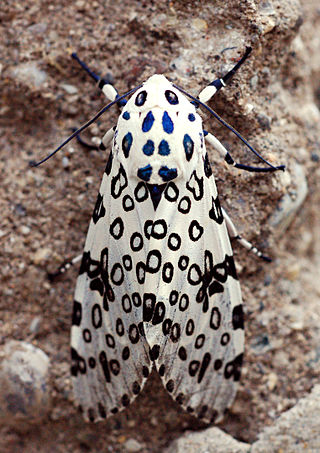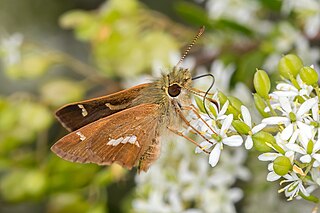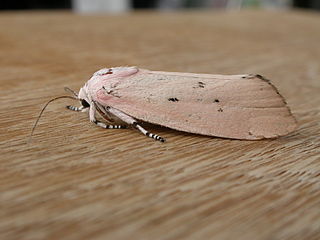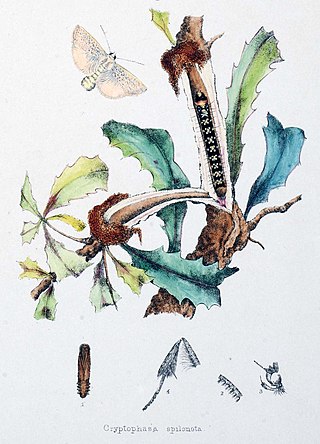
The luna moth, also called the American moon moth, is a Nearctic moth in the family Saturniidae, subfamily Saturniinae, a group commonly named the giant silk moths.

Saturnia pavonia, the small emperor moth, is a moth of the family Saturniidae. It was first described by Carl Linnaeus in his 1758 10th edition of Systema Naturae. Sometimes, the incorrect genus name Pavonia is still used for this species. This moth occurs throughout the Palearctic region and is the only member of its family to be found in the British Isles, where it is usually called simply the emperor moth.

The yellow-tail, goldtail moth or swan moth is a moth of the family Erebidae. The species was first described by Johann Kaspar Füssli in 1775, and has commonly been placed within the related genus Euproctis. It is distributed throughout Europe to the Urals, then east across the Palearctic to Siberia and south to India and Sri Lanka.

The giant leopard moth is a moth of the family Erebidae. They are distributed through North America from southern Ontario, and southern and eastern United States through New England, Mexico, and south to Colombia. The obsolete name, Ecpantheria scribonia, is still occasionally encountered.

Lampides boeticus, the pea blue, or long-tailed blue, is a small butterfly that belongs to the lycaenids or gossamer-winged family.

Hyles gallii, the bedstraw hawk-moth or galium sphinx, is a moth of the family Sphingidae. The species was first described by S. A. von Rottemburg in 1775.

Dispar compacta, commonly known as the dispar skipper, barred skipper, or barred grass-skipper, is a species of butterfly in the family Hesperiidae. It was described by Arthur Gardiner Butler in 1882 as Telesto compacta and is endemic to eastern Australia.

Cryptophasa hyalinopa is a moth of the family Xyloryctidae. It is known from Queensland, Australia.

Cryptophasa delocentra is a moth in the family Xyloryctidae. It was described by Edward Meyrick in 1890. It is found in Australia, where it has been recorded from New South Wales and Queensland.
Cryptophasa epadelpha is a moth in the family Xyloryctidae. It was described by Edward Meyrick in 1890. It is found in Australia, where it has been recorded from New South Wales and Queensland.
Cryptophasa chionodes is a moth in the family Xyloryctidae. It was described by Alfred Jefferis Turner in 1898. It is found in Australia, where it has been recorded from New South Wales and Queensland.
Cryptophasa nigricincta is a moth in the family Xyloryctidae. It was described by Alfred Jefferis Turner in 1898. It is found in Australia, where it has been recorded from Queensland.
Cryptophasa sacerdos is a moth in the family Xyloryctidae. It was described by Alfred Jefferis Turner in 1902. It is found in Australia, where it has been recorded from Queensland.
Cryptophasa stenoleuca is a moth in the family Xyloryctidae. It was described by Oswald Bertram Lower in 1894. It is found in Australia, where it has been recorded from New South Wales, the Northern Territory, Queensland and Western Australia.
Cryptophasa aglaodes is a moth in the family Xyloryctidae. It was described by Oswald Bertram Lower in 1894. It is found in Australia, where it has been recorded from the Northern Territory, Queensland, South Australia and Victoria.
Cryptophasa ochroleuca is a moth in the family Xyloryctidae. It was described by Oswald Bertram Lower in 1892. It is found in Australia, where it has been recorded from the Australian Capital Territory, New South Wales, South Australia and Victoria.
Cryptophasa diplosema is a moth in the family Xyloryctidae. It was described by Oswald Bertram Lower in 1903. It is found in Australia, where it has been recorded from Queensland.
Cryptophasa nubila is a moth in the family Xyloryctidae. It was described by Thomas Pennington Lucas in 1894. It is found in Australia, where it has been recorded from New South Wales and Queensland.
Cryptophasa balteata is a moth in the family Xyloryctidae. It was described by Francis Walker in 1866. It is found in Australia, where it has been recorded from New South Wales, Queensland and South Australia.

Cryptophasa spilonota is a moth in the family Xyloryctidae. It was described by Scott in 1864. It is found in Australia, where it has been recorded from New South Wales and Queensland.












